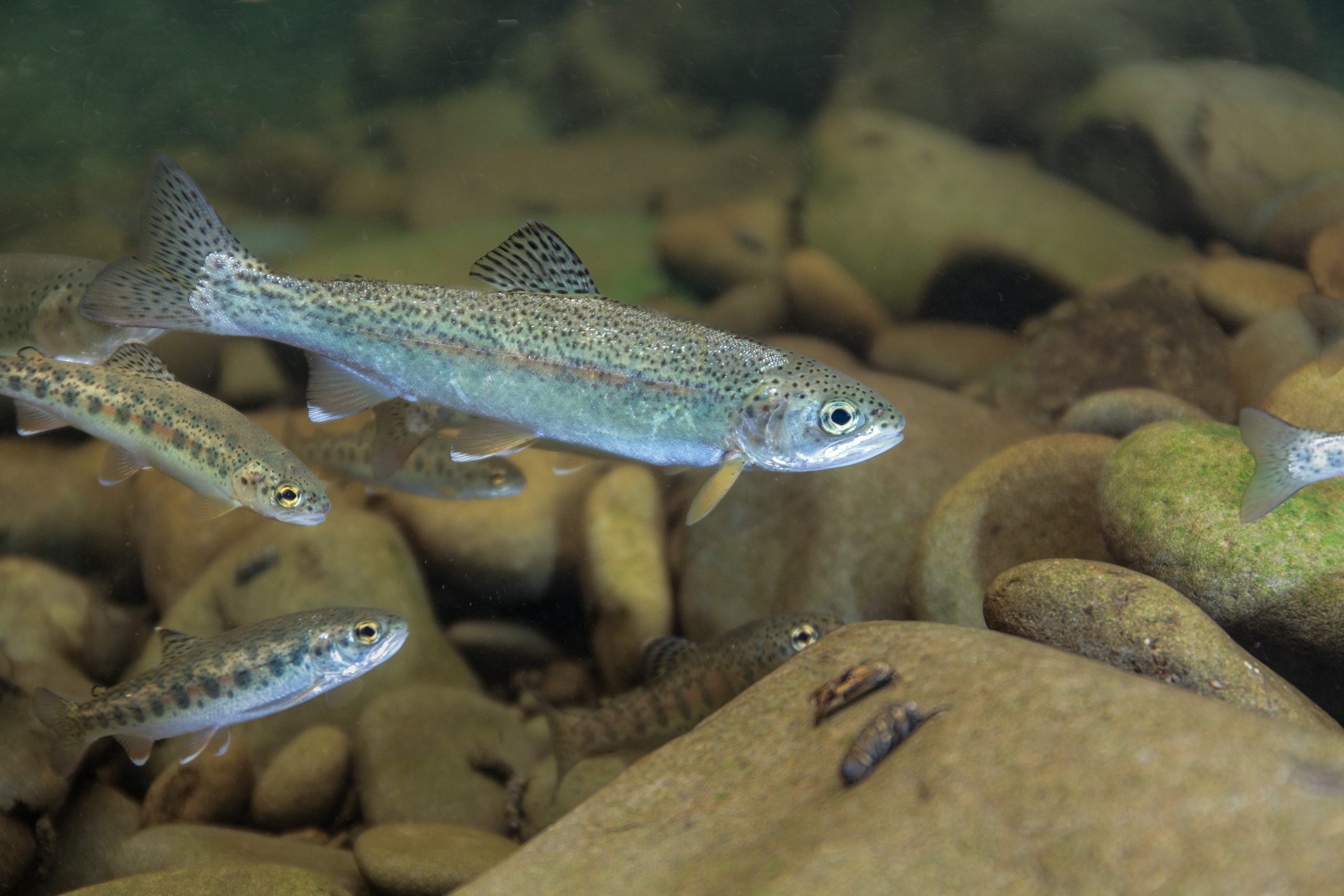What a growing body of scientific literature means for managing and pursuing both resident AND anadromous trout and how exactly a PNW-based conservation group is taking action.
There seems to be quite a few more two-handed rods out there on the local trout streams these days.
An unfortunate reality is that many swung fly enthusiasts are turning to trout spey not by choice, but instead as a reaction to the decline of sea-faring species; some forced by seasonal closures and others voluntarily.
But, as the saying goes, “there’s no free lunch.”
We know steelhead and rainbow trout are the same species, but, what factors determine whether fish stick around or head for the salty pond? What IS the role of resident wild trout in sustaining the populations of anadromous fish at the core of our swing-sperience? How important is that role compared to the unfortunate myriad of issues facing native anadromous fish? Equally crucial is to first recognize and then consider is just how much we DON’T know and how those variables could unknowingly contribute to the already tragic decline of anadromous stocks.
In today’s world, many things appear deeply partisan. Divided. Black & white. But, it appears what’s more important than ever for spey anglers across the northern hemisphere to remember is that the growing body of literature indicates the biological threshold between the wild resident trout in your backyard stream and a mighty wild steelhead is thin, and how we fish and manage for their interdependence is – believe it or not — largely unknown.
Nature, Nurture AND….
The salmonine species (Salmo, Oncorhynchus, and Salvelinus) exhibit life histories broadly classified as resident and anadromous (among others.). Most of you may already know this, but, as a reminder, residents complete their entire life cycle in freshwater while anadromous individuals migrate from their natal freshwater streams to the ocean to access rich feeding areas before returning to spawn in freshwater.
Generally, anadromous fish that spend multiple years in the ocean will grow to a much larger size than resident fish. The catch is, however, that in places like Bristol Bay, Alaska, where food sources i.e. eggs and salmon flesh return to the rivers, residents can attain large sizes approaching that of anadromous individuals. In fact, a limited food supply in freshwater, causing intense competition for food is what is believed to be one factor leading to the evolution of migratory behavior in the first place!
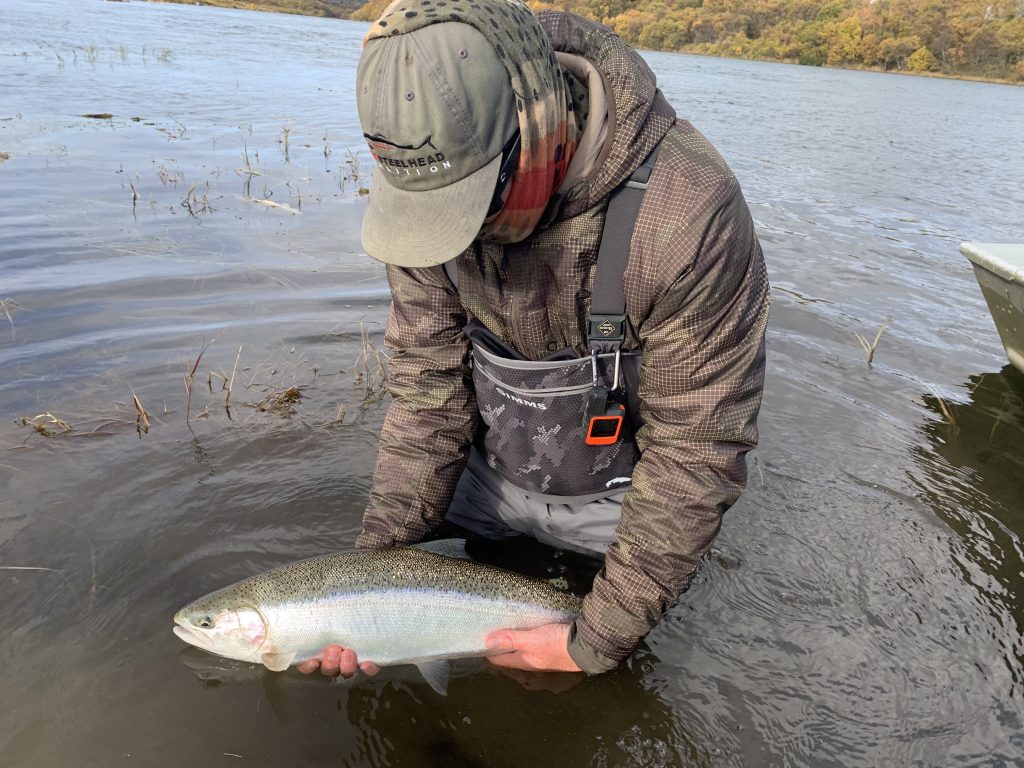
“Rainbow trout started out as residents, not anadromous. The planet didn’t get cold enough for anadromy to evolve in a species like salmon until about 2-4 million years ago. Unfortunately, due to climate change the planet is now approaching temperatures that were too warm for anadromy, which is why I’m so concerned about ocean-going life histories looking forward, “ John McMillan, Science Director for The Conservation Angler told Swing The Fly.
Life histories are “decided” for lack of a better term during the juvenile stage, either during the first few months of life when a fish is termed a “fry” or in the following year when they grow larger and are known as a “parr”, which refers to the vertical oval-shaped bars on their sides. Ultimately, a parr will follow one of two potential life history trajectories: smoltification or maturation.
Smolting is characterized by hormonal and other physiological changes that occur in parr to prepare the fish for life in salt water, which includes the loss or fading of parr marks and the appearance of a silvery color (and osmoregulation for life in saltwater).Instead of smolting, other individuals will experience increased levels of particular testosterones that trigger a hormonal cascade that results in maturation, thus becoming a resident.
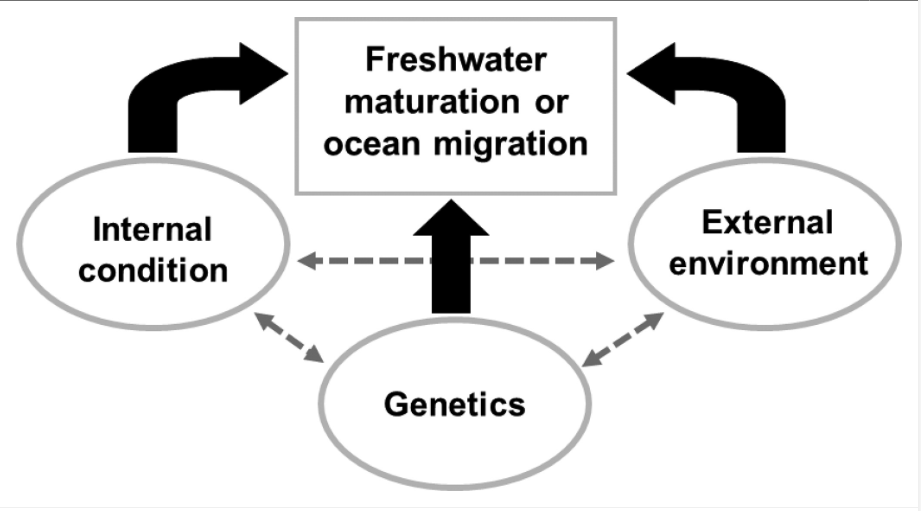
Genetically identical — with both being Oncorhynchus Mykiss – resident rainbow trout can produce steelhead and a steelhead can produce a resident rainbow trout, which indicates there is an environmental role in whether one fish becomes a steelhead or a trout. However, there are some underlying genetic differences between the life histories, and this could explain why research on the Grande Ronde River, Oregon found that trout x trout matings generally produced a greater proportion of resident trout compared to steelhead x steelhead matings, which produced a greater proportion of steelhead. (James et al., 2009)
Hence, patterns in life history expression are the result of a complex interaction between genetics and environment.
The influence of parental genetics can be seen in the heritability of particular traits that are passed onto offspring. This heritability is commonly referred to as the “genetic” component. The presence and opportunity for parents to produce offspring of multiple life histories within a single population is called genetic polymorphism. Broad scale heritability estimates for salmonid species suggests as much as 30-50 percent of life history development is regulated by genetics.
It therefore goes without saying that as much of 50-70% of the life history “decision” is determined by an individual’s physiological response to its juvenile rearing conditions, such as water temperature, food supply, and competitor density.
This interaction between the heritable traits (genetic) and the aforementioned “responses” (environment) and the interaction’s influence on how life histories develop is explained by a theory called conditional strategy.
The conditional strategy posits: “First, individuals inherit variations in particular traits that influence growth. The trait that is increasingly being used to understand anadromy and residency is metabolism, which tends to vary among juveniles that adopt different life histories. Secondly, individuals display a wide range in growth because of differences in the ecology of their rearing habitat and variable metabolisms. Lastly, a life history is adopted based on hormonal shifts in body physiology that are associated with two measures of individual condition, growth in length and fat storage. These measures of condition provide a means of physiological feedback between an individual and its environment. Anthropomorphically, length and fat are cues that ‘tell’ the body about the quality of the growing conditions of its habitat. Different combinations of length and fat during the parr stage trigger or delay maturation and smolting.” – Kendall et. al. 2015.
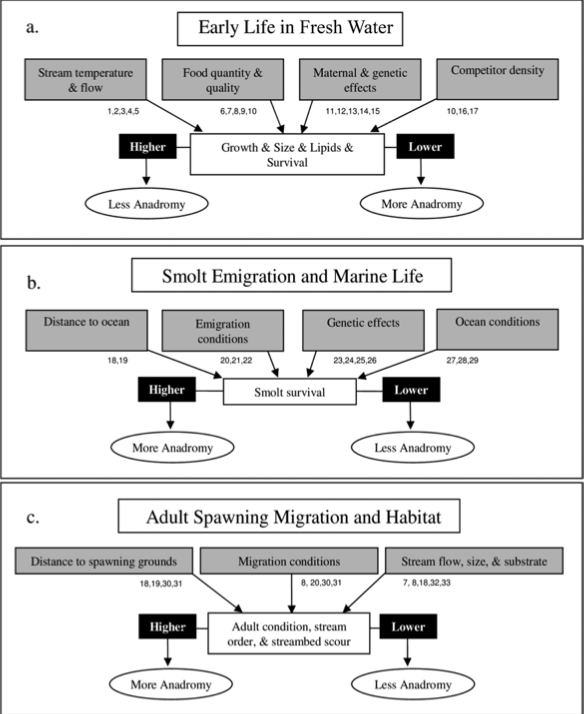
Sexual Preference
Of course, many species display anadromous and resident life histories within a single population.
“The coolest thing about this, there are really two kinds of rainbow trout populations. True self-sustaining populations that have a mix of male and female, like the Deschutes, the Yakima, the Rogue, the Sacramento. Those are typically streams from the interior of the West, or at least have their headwaters in the Cascade Range. The more volcanic geology influences streamflow, water temperature, and productivity, and the rivers are large enough and have sufficient diversity in habitat to support two life history populations.
In contrast, rivers like the Sol Duc, the Queets, and other coastal rivers tend to be smaller, steeper, receive more rainfall, and have less volcanic geology, all of which tends to make them inherently less productive for growing large trout. Instead, in many coastal rivers we see smaller populations of rainbow trout, often much so, and the rainbow trout are often predominantly male (up to 70-90 percent male),” McMillan explained. “In situations where steelhead and rainbow trout co-exist, there can also be a large difference in the ratio of males to females in each respective life history. For example, research indicates steelhead life histories are often female biased (55 – 75-percent), and in places like the Columbia River, they often become increasingly female dominant the further their natal tributary is from the coast. One reason for that is males tend to mature as residents more frequently than females, and as such, more females tend to migrate to sea.”
In contrast, rivers like the Sol Duc, the Queets, and other coastal rivers tend to be smaller, steeper, receive more rainfall, and have less volcanic geology, all of which tends to make them inherently less productive for growing large trout.
Females are more likely to become anadromous than males because that strategy provides the greatest opportunity for large size. Larger females tend to carry more eggs, are able to excavate redds in a wider range of substrates, can dig deeper redds to reduce scour and dewatering, and may outcompete smaller females for the best spawning areas. In contrast, it is believed that more males mature as residents because their reproductive success is based on the number of eggs fertilized and even a tiny male has enough sperm to fertilize all the females in a population Larger males may acquire more matings than smaller individuals, but, males have evolved a number of behavioral strategies that ensure a wide range of sizes of fish can acquire fertilization opportunities.
The drawback to anadromy? Mortality increases with every extra year of life it takes to achieve maturity, and mortality can be especially high during emigration to and the first year of life in the ocean. The main advantage of maturing earlier in life, often at a smaller size, is a reduced chance for mortality. Thus, the tradeoff between mortality risk and size is apparently worth the risk more so for females than males.

“My simple answer is,” McMillan states. “Give a fish enough food for it to grow fast and put on fat, it won’t need to migrate because its needs have been met. Further risk isn’t worth it. In contrast, a hungry fish that is growing slowly will migrate as far as necessary to meet its needs, regardless of the risk.
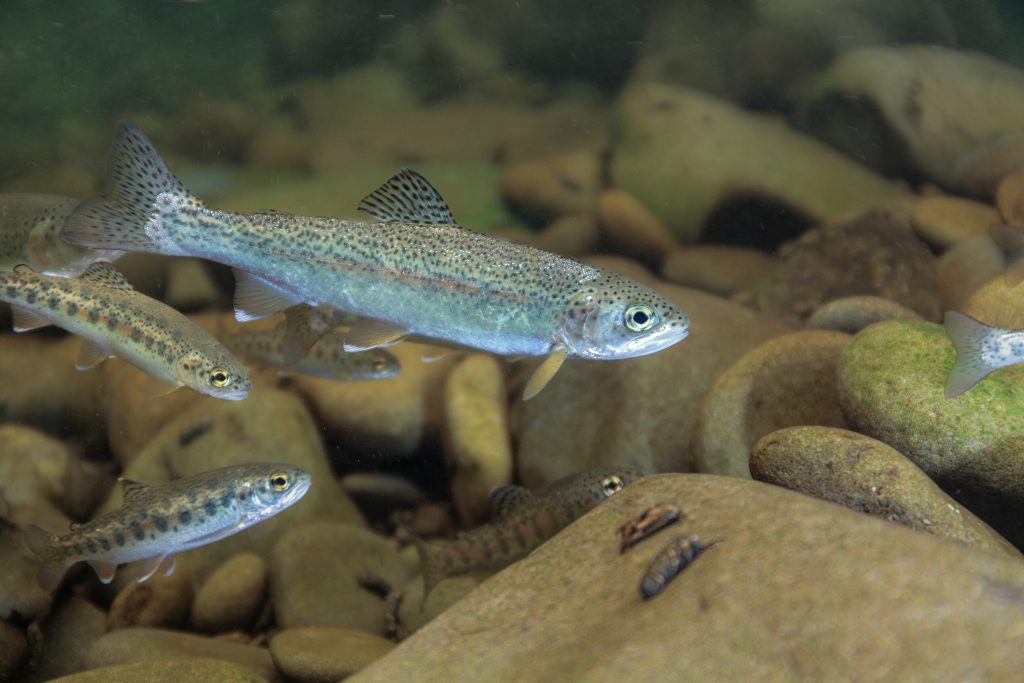
Investing In Residency
If Hatcheries Are the Answer, What Was the Question?
“Hatchery managers and fishery management agencies must now face the fact that the previous genetics studies and published information are not relevant nor accurate without the integration of epigenetics” explains Guy Fleischer, science advisor for the Wild Steelhead Coalition, citing a body of research on the documented impact on steelhead gene expression from hatchery practices. “Hatchery-induced genetic alterations decrease fitness of the fish and their subsequent offspring. Even though wild steelhead have evolved to adapt and adjust to past natural conditions, the one they have not had to face over the eons is the impact of the insidious epigenetic programming leading to systematically reduced fitness that can be spread from artificial propagation.”
“Overlooked is the ecological fact that these fish already have a natural built-in ‘hatchery system’ by means of resident fish,” says Fleischer . “It is time to recognize those life history strategies and epigenetic traits that have been honed over the eons. Fixated on spawning runs, we have forgotten the critical role that freshwater residency plays in maintaining wild steelhead. Case in point: The noted dam removal on the Elwha River in Washington State. Those fish stranded above the impoundment retained the ability to find their way back to the saltwater to continue what they have been doing for eons. The dam actually protected them from the denigrating influence of hatchery fish, and once freed, are showing their time-tested natural abilities. Another encouraging example is the winter steelhead population in the North Umpqua in Oregon. These wild fish with access to suitable river habitat have increased dramatically after the cessation of stocking of hatchery fish, a rare trajectory at a time when populations elsewhere are struggling over most of the entire West Coast. The obvious conclusion: wild steelhead, when allowed, continue to display they have the ‘right stuff.”
Removing Dams, Instilling Hope
“While as a scientist, I’m imminently fearful for the future because of climate change; the one example of human change that makes me feel more hope than anything else is dam removal,” McMillan offered. “Looking at the White Salmon River, the Elwha, they’ve all shown really amazing responses from steelhead in particular. My suspicion is that removing those barriers to migration will greatly increase the amount of juveniles that can get out to the ocean and if they can survive at similar rates to fish in the lower section of the river, I think we’ll see an increase.”
“People will be looking 40, 50, 60 years down the road on the Klamath and we can say the fishing will be better than that it is now. How many places can you say that?!.”
-John McMillan
Fleischer and McMillan independently alluded that in addition to the refinement of hatchery programs and dam removal, fisheries management plays a large role in maintaining resident trout populations. Most of all in coastal rivers where the resident rainbow trout populations are small enough already if a significant portion of those already small populations are impacted, populations could quickly dwindle.
“You’ve got to regulate our fisheries in a way that those resident trout are important,” McMillan said. “What if you get a period of REALLY bad ocean survival, resident rainbows may become more abundant, hold the mantle for a while, and potentially even pass along genes that could assist anadromous survival.”
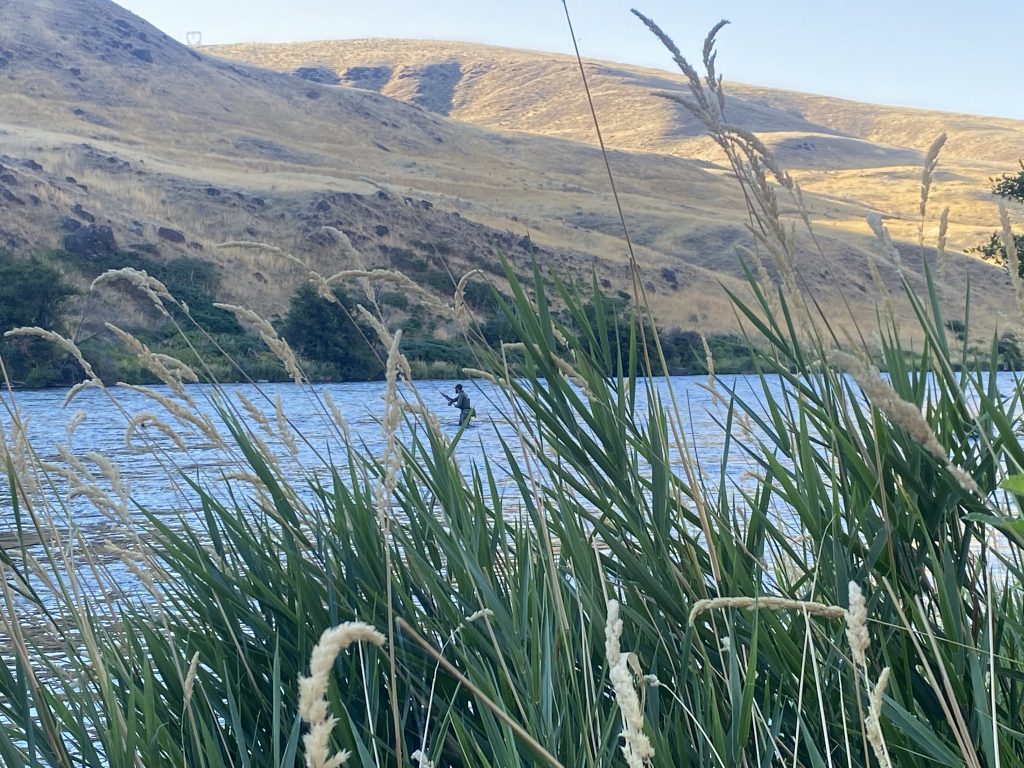
Scientifically The Same, Legally Different
Here, it’s important to note that no one’s advising hedging our bets on resident trout being the salvation of wild steelhead on anything less than a truly geological scale. While we are rapidly discovering more and more about the importance of maintaining life history diversity, wild resident and wild steelhead are recognized and managed appropriately as distinct population segments.
This is a point clarified in no uncertain terms in Modesto Irrigation District v. Gutierrez, an appeal heard by the United States 9th Circuit Court in 2009.
In this case, a federal judge reaffirmed the biological and legal definitions of a species is not exclusively reserved to the population’s ability to interbreed.
“We agree with the district court that under the ESA, interbreeding is not alone determinative of whether organisms must be classified alike where, as here, they develop and behave differently,” Judge Mary M. Schroeder’s opinion states.
Therefore, while resident trout do hold an important key to the persistence of anadromous life history expression, the acute distinctions between residency and anadromous populations continue to make responsible fisheries management a moving target.
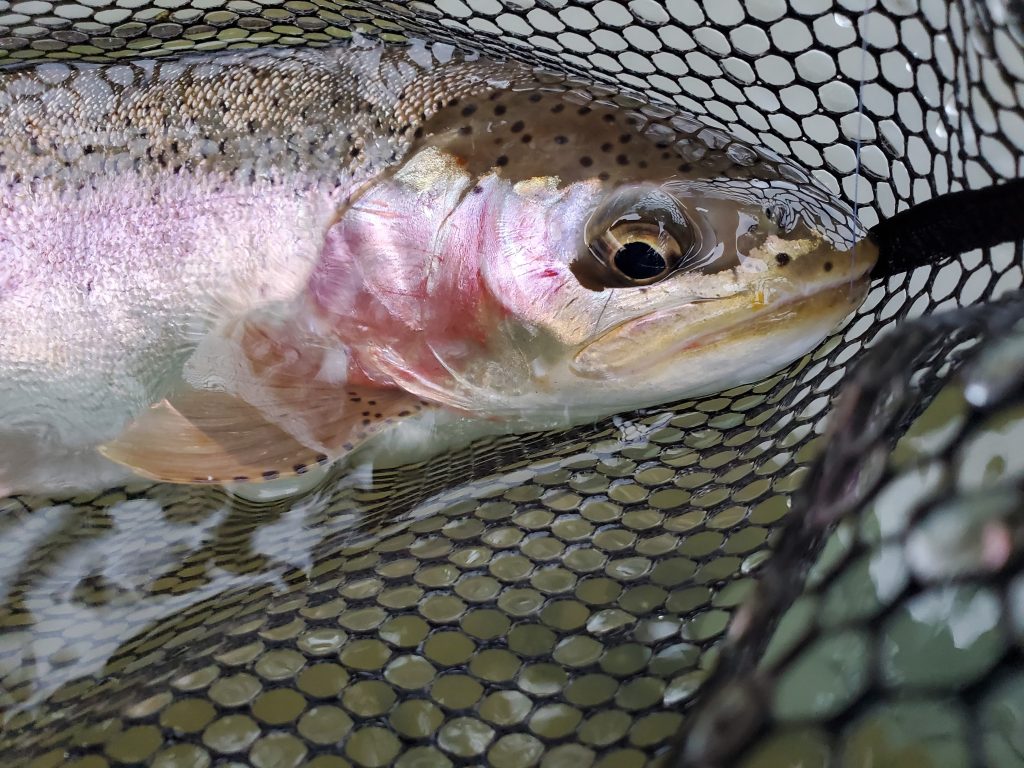
Managing For What We Know, and Don’t
“It’s a basic management principle, a management strategy that supports life history diversity produces more resilient populations, “ James Losee, Coastal Region Fish Program Manager for Washington Department of Fish & Wildlife (WDFW) told Swing The Fly.
“What scares me most of all is what if we learn all of this too late?” Losee admitted. “There’s good logic in the regulations in place, good people, good work and good science behind them. But, science is building rapidly and steelhead aren’t doing great at the moment, so the question we’re asking ourselves is ‘do we know anything now that we didn’t know then that suggests we should change this rule?”
The “rule” Losee is referring to is the foundation of WDFW’s current trout regulations, A Basic Fishery Management Strategy For Resident And Anadromous Trout In The Stream Habitats Of The State Of Washington” (October, 1984.) Under this guiding document, a number of current regulations in WA based on this document allow for the harvest of two trout of over 14” in streams, which was designated to allow a majority of mature adult resident fish to spawn at least once.
Losee suggested watersheds where steelhead productivity is low would be ideal places to experiment with resident trout regulations to see how they influence anadromous returns.
“Take the Nisqually River for example, where recent research showed as high as 20-percent of smolts had mothers that had never been to the ocean. The Chehalis is another great example of a place that produced resident rainbow trout but suffers from low steelhead survival,” Losee said. “The jury is really out and there isn’t a ton of great data showing really high successful return rates by smolts born of resident rainbow trout parents, but, if these smolts weren’t there, think about it, you could just skim that 20-percent right off the top.”
“It seems as if the body of literature is growing rapidly on the importance of these resident fish. The goal, long-term, is of course for people to be able to fish how they want,” Losee said. “But that may mean that right now, we have to ask hard questions.about the role of resident trout.”
Losee reminded Swing The Fly that while managing the agency’s mandates for both opportunity and conservation can be a challenge, if WA residents want to harvest a rainbow trout, there is a bounty of regularly stocked lakes at their disposal across the state and rivers that likely produce resident trout populations that support harvest.
When fish and game commissions consider their respective mandates, for example in Washington State to “preserve, protect and perpetuate fish and wildlife and to provide fishing and hunting opportunities,”, the real question it seems anglers need to ask ourselves is, “what do sportsmen desire when balancing opportunity and conservation when their management agencies simply don’t have data to support potentially harmful regulations – well intentioned as they may be?”
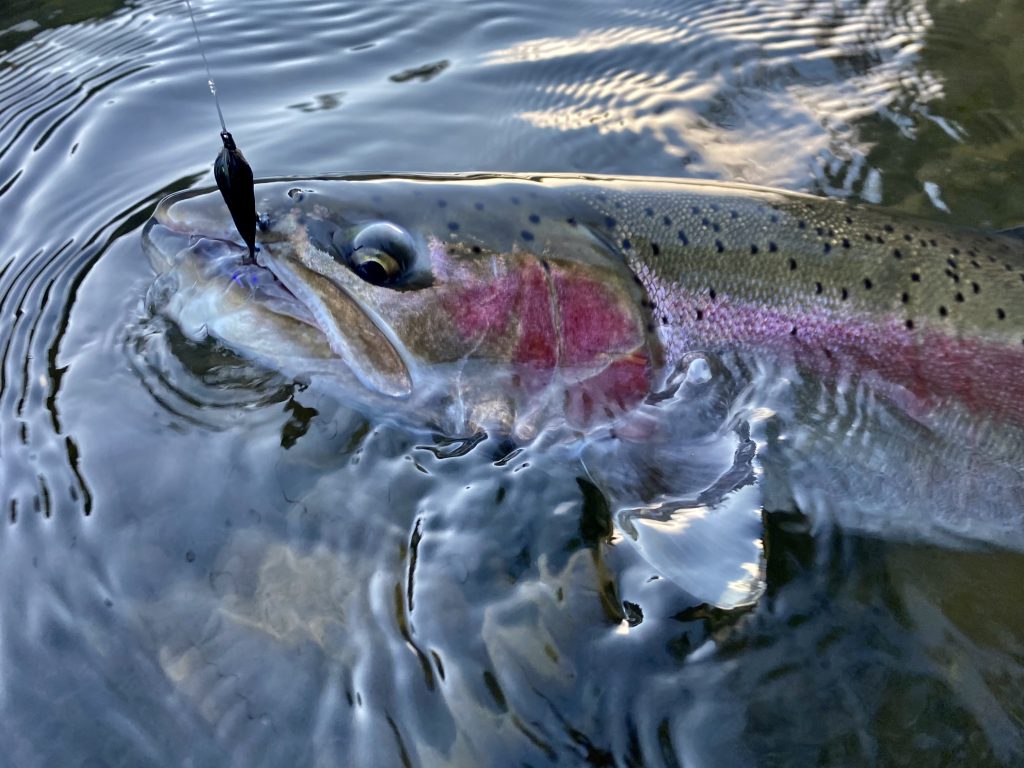
Looking Forward, Taking Action
“Wild Steelhead Coalition (WSC) sees an opportunity that has value to the conservation of wild steelhead,” Rich Simms, a founding member and board member of WSC said. “We’re interested in making tangible change.”
Simms, Fleischer and the team at WSC are actively developing a petition to be submitted to WDFW in the near future for statewide protection of resident forms of wild steelhead. WSC believes rules changes aimed at conserving resident trout — particularly in watersheds with wild steelhead runs — will encourage genetic integrity that, coupled with preserved or recovered river habitats, will go a long way to ensure viable steelhead populations, particularly in the face of a combination of stresses that include those from inevitable climate change.
But Simms is clear to point out that while rule changes are a positive and important progression, it’s education, awareness and adoption by anglers that will change the status quo.
Whether pursuing trout on the swing is a new pursuit or a change-of-pace from your regularly favored anadromous species, there’s no better time than now to recognize that at the end of the day, the more we know, and then more things change, the more they are the same.
Maybe a bit smaller. But, not always.
Citations and Resources
Neala W. Kendall, John R. McMillan, Matthew R. Sloat, Thomas W. Buehrens, Thomas P. Quinn, George R. Pess, Kirill V. Kuzishchin, Michelle M. McClure, Richard W. Zabel, 2015, Anadromy and residency in steelhead and rainbow trout (Oncorhynchus mykiss): a review of the processes and patterns, Canadian Journal of Fisheries and Aquatic Sciences, 5 November 2014 https://doi.org/10.1139/cjfas-2014-0192
Fraik, A.K.; McMillan, J.R.; Liermann, M.; Bennett, T.; McHenry, M.L.; McKinney, G.J.; Wells, A.H.; Winans, G.; Kelley, J.L.; Pess, G.R.; et al. The Impacts of Dam Construction and Removal on the Genetics of Recovering Steelhead (Oncorhynchus mykiss) Populations across the Elwha River Watershed. Genes 2021, 12, 89. https://doi.org/ 10.3390/genes12010089
James, R. R., Clarke, L. R., Carmichael, M. W., & Eddy, D. L. (2009). PERFORMANCE OF PROGENY FROM STEELHEAD AND RAINBOW TROUT CROSSES. LOWER SNAKE RIVER COMPENSATION PLAN: OREGON EVALUATION STUDIES. https://www.fws.gov/sites/default/files/documents/Steelhead%20and%20Rainbow%20Trout%20Crosses%202009.pdf
New Evidence That Hatchery Practices Trigger Changes In Steelhead By Altering Gene Expression – Wild Steelhead Coalition
https://www.wildsteelheadcoalition.org/news/hatchery-gene-expression
Steelhead’s Missing Year’s – Wild Steelhead Coalition
https://www.wildsteelheadcoalition.org/news/steelheads-missing-years

